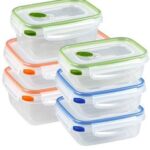Packaging for meat, fish, and poultry products is crucial for ensuring food safety, freshness, and quality. Here are some key considerations and elements to include in packaging for these perishable food items:
Material Selection: Choose packaging materials that provide a barrier against oxygen, moisture, and light to preserve freshness and prevent spoilage. Common materials include vacuum-sealed plastic pouches, shrink-wrap film, foam trays with plastic overwrap, and modified atmosphere packaging (MAP) materials.
Labeling Requirements: Ensure compliance with regulatory labeling requirements, including product name, weight or quantity, expiration date, nutritional information, country of origin, and handling instructions (e.g., “Keep Refrigerated”). Labels should be clear, legible, and securely attached to the packaging.
Tamper-Evident Packaging: Implement tamper-evident seals or closures to assure consumers that the product has not been tampered with or contaminated during handling and transportation.
Freshness Indicators: Consider incorporating freshness indicators such as time-temperature indicators or color-changing labels to provide visual cues of product quality and shelf life.
Sustainable Packaging: Use environmentally friendly packaging materials whenever possible, such as recyclable or biodegradable options. Minimize packaging waste by optimizing package sizes and reducing unnecessary materials.
Leak Resistance: Ensure that packaging materials are leak-resistant to contain any juices or liquids released by the product, reducing the risk of cross-contamination and maintaining cleanliness during handling and storage.
Freezer Compatibility: If the product is intended for freezing, choose packaging materials that are suitable for freezer storage and protect against freezer burn. Vacuum-sealed bags and freezer-grade plastic wraps are commonly used for frozen meat, fish, and poultry.
Portion Control: Consider portion-controlled packaging options to facilitate meal planning and portioning for consumers. This can include individually wrapped cuts of meat or fish or pre-portioned servings in trays.
Promotional Information: Use packaging as an opportunity to communicate product information, such as product origin, farming practices, certifications (e.g., organic, sustainable), and cooking instructions or recipe suggestions.
Hygiene and Safety: Ensure that packaging facilities adhere to strict hygiene standards to prevent contamination of the product during packaging. Use food-grade packaging materials and implement Good Manufacturing Practices (GMP) and Hazard Analysis and Critical Control Points (HACCP) protocols.
Ventilation: Some fresh products, such as live seafood, may require packaging with ventilation to allow for air circulation and prevent the buildup of moisture and odors.
Customization: Tailor packaging designs to meet the specific needs of different product types (e.g., whole fish vs. fillets) and customer preferences (e.g., clear packaging for easy product visibility).
By addressing these considerations in meat, fish, and poultry packaging design, you can help ensure product safety, quality, and consumer satisfaction throughout the supply chain, from production to consumption.






